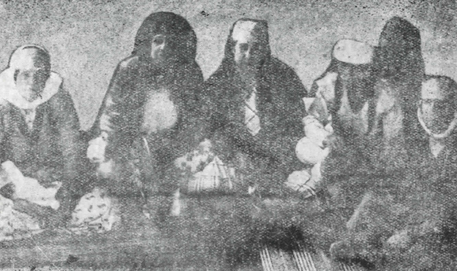If you are interested in having a traditional Jewish henna ceremony, for a marriage or for any other happy occasion, or interested in having me speak to a group about Jewish henna traditions, please contact me!
See here for an overview of Jewish henna traditions in general, and Jewish henna in Israel today.
This information is the result of my own research. Please do not copy this information without proper citation.
See here for an overview of Jewish henna traditions in general, and Jewish henna in Israel today.
This information is the result of my own research. Please do not copy this information without proper citation.
Jewish Henna Traditions in Iraq

A rare photo of the daqqaqat, an all-women drumming troup, early 20th century.
The Jewish community in Iraq is very old, and Iraq was the centre of Jewish learning and culture from approximately the 3rd century C.E. until the Middle Ages. The Iraqi Jewish community was generally integrated into the surrounding society, and Jews played an important part in the cultural, civic, and bureaucratic life of Iraq. While Baghdad was the unquestioned centre of Jewish life in Iraq, there were also important Jewish communities in Mosul, Ramadi, and Kifl (and this does not include the large population of Kurdish Jews living in Iraqi Kurdistan). Iraqi Jewish merchants and traders established expatriate communities in places like India, Burma, and China, where they maintained their Iraqi customs.
Like Persian Jews, henna was used as a cosmetic among Iraqi Jews, especially to dye hair. Some Jewish women would make sure to henna their hair on Fridays, in honour of the Sabbath.
Iraqi Jews held a henna ceremony, which they termed leilat al-ḥinni, 'the night of the henna', the evening before the wedding. It was sometimes also known as khuṭba ['engagement', literally 'marriage proposal']. In the 19th century, according to travellers' reports, both the bride and the groom had her hands and feet hennaed solidly. By the early 20th century, however, it had become the custom in Iraq to henna only the bride's fingertips, and just one finger of the groom's. This was similarly practiced among Baghdadi communities in Yangon (Burma), Kolkata (India), and Shanghai (China).
Like Persian Jews, henna was used as a cosmetic among Iraqi Jews, especially to dye hair. Some Jewish women would make sure to henna their hair on Fridays, in honour of the Sabbath.
Iraqi Jews held a henna ceremony, which they termed leilat al-ḥinni, 'the night of the henna', the evening before the wedding. It was sometimes also known as khuṭba ['engagement', literally 'marriage proposal']. In the 19th century, according to travellers' reports, both the bride and the groom had her hands and feet hennaed solidly. By the early 20th century, however, it had become the custom in Iraq to henna only the bride's fingertips, and just one finger of the groom's. This was similarly practiced among Baghdadi communities in Yangon (Burma), Kolkata (India), and Shanghai (China).
The groom would send the henna to the bride’s house along with presents for her and her family, including sweets, candles, gloves and shoes. Traditionally the groom's mother would present the bride with a substantial piece of jewelry. The bride’s fingertips (and the groom's finger) were hennaed and wrapped in silver paper, refreshments were served, and musicians provided entertainment. Two genres of Iraqi music were played specifically at henna ceremonies: chalghi baghdad, an instrumental ensemble that sang popular Iraqi songs, and the daqqaqat, an all-women drumming troupe.
Sources and References:
Avishur, Yiṣḥaq. 1990 Haḥatuna hayehudit beBagdad uvebenoteiha, Kerakh Rishon: minhagim, ṭeqasim, umismakhim [The Jewish Wedding in Baghdad and Surrounding Areas, Volume One: customs, rituals, and documents].
Benjamin, Israel Joseph. 1858 Acht Jahre in Asien und Afrika [Eight Years in Asia and Africa].
Benjamin, Marina. Last Days in Babylon: the history of a family, the story of a nation.
Ben-Mordechai, Galia. 1992 The Musical Culture of Iraqi Jewry: Three Countries and Two Continents. The Canadian Journal for Traditional Music, Vol. 20.
Cernea, Ruth. 2007 Almost Englishmen: Baghdadi Jews in British Burma. Lanham: Lexington Books.
Elias, Flower, and Judith Cooper. 1974 The Jews of Calcutta.
Kattan, Naim. 2007 Farewell, Babylon: coming of age in Jewish Baghdad.
Meyer, Maisie. 2003 From the Rivers of Babylon to the Wangpoo: A Century of Sephardi Jewish Life in Shanghai.
Musleah, Ezekiel. 1975 On the Banks of the Ganga: The Sojourn of the Jews in Calcutta.
Sassoon, David. 1949 A history of the Jews in Baghdad.
Shamash, Violette. 2008 Memories of Eden: a journey through Jewish Baghdad.
Benjamin, Israel Joseph. 1858 Acht Jahre in Asien und Afrika [Eight Years in Asia and Africa].
Benjamin, Marina. Last Days in Babylon: the history of a family, the story of a nation.
Ben-Mordechai, Galia. 1992 The Musical Culture of Iraqi Jewry: Three Countries and Two Continents. The Canadian Journal for Traditional Music, Vol. 20.
Cernea, Ruth. 2007 Almost Englishmen: Baghdadi Jews in British Burma. Lanham: Lexington Books.
Elias, Flower, and Judith Cooper. 1974 The Jews of Calcutta.
Kattan, Naim. 2007 Farewell, Babylon: coming of age in Jewish Baghdad.
Meyer, Maisie. 2003 From the Rivers of Babylon to the Wangpoo: A Century of Sephardi Jewish Life in Shanghai.
Musleah, Ezekiel. 1975 On the Banks of the Ganga: The Sojourn of the Jews in Calcutta.
Sassoon, David. 1949 A history of the Jews in Baghdad.
Shamash, Violette. 2008 Memories of Eden: a journey through Jewish Baghdad.
Pictures from:
Avishur, Yiṣḥaq. 1990 Haḥatuna hayehudit beBagdad uvebenoteiha, Kerakh Rishon: minhagim, ṭeqasim, umismakhim [The Jewish Wedding in Baghdad and Surrounding Areas, Volume One: customs, rituals, and documents].
The Oster Visual Documentation Center of Beit haTfutsot: The Museum of the Jewish People, www.bh.org.il.
The Oster Visual Documentation Center of Beit haTfutsot: The Museum of the Jewish People, www.bh.org.il.
